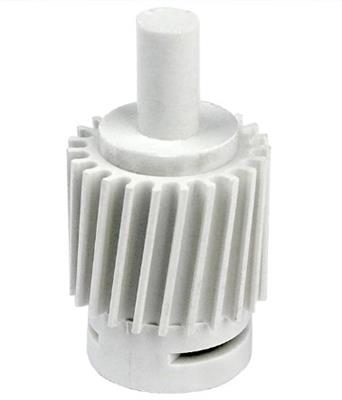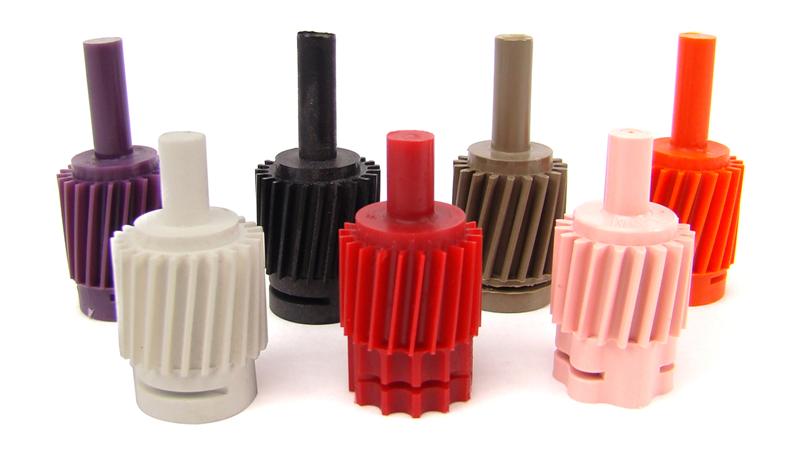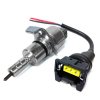Hoping you can help a new guy. This is for a 1967 mustang but I don't think that really matters. I have a new T5z transmission and an electronic speedometer/instrument panel from New Vintage USA that came with a vehicle speed sender/sensor thing that looks like below. It is a 3 wire Hall effect unit and I am pretty sure I have it wired properly. It lights up and wants to program per the instructions but after reading "SELF Hi" as it should and pushing the little red button at the end of a measured mile it reads "CALC ing" as it should and then wont program. The speedometer needle doesn't move and the odometer doesn't record miles driven. I don't have a traditional Speedometer cable because I don't think I'm supposed to need one for this. I think I have the sensor attached to the transmission correctly. There is a little oblong metal end on the sensor into the transmission. Is there supposed to be something that fits over that end before installing it? I called New Vintage and they suggested I call CJ Pony Parts to see what they have. CJ Pony didn't know what I was even talking about even after consulting a supervisor. They said they don't have anything for that. I'm dumb about things like this and all the other instruments work fine. What am I missing or doing wrong? Help?
Navigation
Install the app
How to install the app on iOS
Follow along with the video below to see how to install our site as a web app on your home screen.

Note: This feature currently requires accessing the site using the built-in Safari browser.
More options
-
Hello there guest and Welcome to The #1 Classic Mustang forum!
To gain full access you must Register. Registration is free and it takes only a few moments to complete.
Already a member? Login here then!
You are using an out of date browser. It may not display this or other websites correctly.
You should upgrade or use an alternative browser.
You should upgrade or use an alternative browser.
Newbie needs help with a T5 to speedometer connection
- Thread starter Beeford
- Start date
It needs a plastic gear on the shaft that sticks out and meshes with the gear in the transmission. The gear you use is based on the gear ratio you have out back and probably the diameter of the rear tire you are using as well.

 www.summitracing.com
www.summitracing.com
Here is one of many calculators you can use to determine which gear you need.

 lmr.com
lmr.com

Steeda 392-STE-17271-D Steeda Speedometer Drive Gears | Summit Racing
Free Shipping - Steeda Speedometer Drive Gears with qualifying orders of $109. Shop Speedometer Gears at Summit Racing.
Here is one of many calculators you can use to determine which gear you need.

Mustang Speedometer Gear Calculator - LMR.com
Get the right speedometer gear for your 1979-98 Mustang based off of rear gear ratio & tire size! No guessing with this Mustang Speedometer Gear Calculator!
Are you sure of this? CJ's said those won't fit and won't work for my application. Also, the sensor works based on "pulses" recorded over a driven mile, so the size of the rear gear or tires shouldn't matter for this type of speedometer. I don't think something with a gear on it is right for this and CJ's seemed certain it wasn't. I'm thinking some sort of magnet thingy that can monitor whatever is spinning by inside the transmission is what I need. But what is that thingy?It needs a plastic gear on the shaft that sticks out and meshes with the gear in the transmission. The gear you use is based on the gear ratio you have out back and probably the diameter of the rear tire you are using as well.

Steeda 392-STE-17271-D Steeda Speedometer Drive Gears | Summit Racing
Free Shipping - Steeda Speedometer Drive Gears with qualifying orders of $109. Shop Speedometer Gears at Summit Racing.www.summitracing.com
Here is one of many calculators you can use to determine which gear you need.

Mustang Speedometer Gear Calculator - LMR.com
Get the right speedometer gear for your 1979-98 Mustang based off of rear gear ratio & tire size! No guessing with this Mustang Speedometer Gear Calculator!lmr.com
And for what it's worth, CJ's has the gears. It's technical assistance where they lack. They are a parts house more than anything. Not saying this is the correct tooth count gear. Just an example. They have others. Use the "calculator" link I provided to determine what you need.
 www.cjponyparts.com
www.cjponyparts.com
Mustang Speedometer Driven Gear Type 3 19-Tooth Automatic/Manual Transmission | CJ Pony Parts
Buy Your Mustang Speedometer Driven Gear Type 3 19-Tooth Automatic/Manual Transmission from CJ Pony Parts, one of the industry leaders for Mustang Parts and Accessories. Order Today!
Like I wrote. They are a parts house. YES you need a gear. YES the ones I am showing you are the correct style. You need to determine the tooth count.
I have a T5 in my car. Built it myself. Put the same pieces in mine to drive/signal my gauge.
I have a T5 in my car. Built it myself. Put the same pieces in mine to drive/signal my gauge.
So if the system works by the pulse count over a driven mile how can the amount of transmission output shaft rotations, rear gear ratio and rear wheel circumference not make a difference?! The car moves as the wheels rotate. The wheels rotate as the transmission turns the driveshaft which turns the rear gears which drive the axles. All of that gearing affects the output of a single transmission shaft rotation in terms of how much of a 360 degree revolution the wheels make (or the distance traversed).
kb3
Well-Known Member
I agree with Terry that you definitely need a gear. I am not so sure the gearing size matters as it calculates pulses vs. mile driven. If it counts the number of pulses for the measured mile, then every mile after that will have the same number of pulses. It shouldn't care whether its 100 or 1000 pulses. I know very little about the unit you are using so Terry could be right. But, yes you need a gear, otherwise that sensor is not measuring anything!
Ken, Ken, Ken. How would the transmission shaft know how far it has traveled just by how many turns it makes? Unless everything behind it is rotating at a 1:1 ratio?I agree with Terry that you definitely need a gear. I am not so sure the gearing size matters as it calculates pulses vs. mile driven. If it counts the number of pulses for the measured mile, then every mile after that will have the same number of pulses. It shouldn't care whether its 100 or 1000 pulses. I know very little about the unit you are using so Terry could be right. But, yes you need a gear, otherwise that sensor is not measuring anything!
The way the VSS piece in the trans works is pretty simple. Think of it as an extension of the output shaft. A gear is affixed to the end which meshes with another gear in the transmission. As the trans turns so does the gear and the small shaft of the VSS. Inside that aluminum housing is some sort of proximity sensor(magnetic) that senses or counts each rotation. Those rotations are the pulse signal sent to the actual gauge which calculates those into travel distance and speed. This is why the tooth count of the gear used is critical to simulate the rear gearing and tire size. Otherwise the pulse count would not correspond to the actual speed and distance traveled.
Take a small flashlight and look into the hole where the VSS piece fits in. You will see the drive gear. You are wanting to know the color. The color will tell you its tooth count. Black is 6, yellow is 7. It is likely one of those two, most likely yellow. Here is an easier calculator to use.
more good info

 www.americanmuscle.com
www.americanmuscle.com
more good info

Ford Mustang Speedometer Gear; 21 Tooth C4OZ-17271-A (83-98 Mustang w/ Manual Transmission) - Free Shipping
FREE SHIPPING! Corrects Speedometer. Changing the rear gears in your Mustang is great for performance, but it will also throw off your speedometer. Now you can
kb3
Well-Known Member
Ken, Ken, Ken. How would the transmission shaft know how far it has traveled just by how many turns it makes? Unless everything behind it is rotating at a 1:1 ratio?
The way the VSS piece in the trans works is pretty simple. Think of it as an extension of the output shaft. A gear is affixed to the end which meshes with another gear in the transmission. As the trans turns so does the gear and the small shaft of the VSS. Inside that aluminum housing is some sort of proximity sensor(magnetic) that senses or counts each rotation. Those rotations are the pulse signal sent to the actual gauge which calculates those into travel distance and speed. This is why the tooth count of the gear used is critical to simulate the rear gearing and tire size. Otherwise the pulse count would not correspond to the actual speed and distance traveled.
The only thing that makes me think differently is he said he pushes a button to “calculate” after driving a “measured mile”. Hence the thought the gear ratio does not play a part. It should count the number of pulses per “measured mile” and go from there. Again, I could be all wet, but it makes logical sense.
I haven't looked up the actual gauge he mentioned (I will now) but it doesn't matter as that VSS piece needs the gear to cause the shaft to rotate with the trans. Some new gauges incorporate a GPS sensor but if his did it wouldn't need a trans signal for anything as the GPS systems do the speed and distance calculation all on their own. He has to push a button so his gauge knows when the car has traveled an actual mile so it can correlate the pulse count it took during that time to the distance and from then on know speed, etc.The only thing that makes me think differently is he said he pushes a button to “calculate” after driving a “measured mile”. Hence the thought the gear ratio does not play a part. It should count the number of pulses per “measured mile” and go from there. Again, I could be all wet, but it makes logical sense.
If not a fully GPS controlled system a speedometer/odometer needs road contact info (tires and full drivetrain) to be able to deduce speed and distance. No other way to do it.
kb3
Well-Known Member
I agree it absolutely needs a gear. But if it has a brain, and knows how many pulses per mile, it can calculate both speed and distance with no regard for actually gearing. Simple math!
And all this time I thought you were at least semi-intelligent.I agree it absolutely needs a gear. But if it has a brain, and knows how many pulses per mile, it can calculate both speed and distance with no regard for actually gearing. Simple math!
So how exactly would it know how far it traveled by simply counting "pulses" made by a rotating transmission shaft? Hmmmmm???
Different gearing or circumference wheels will all travel different distance per trans shaft revolution (same pulse count).
kb3
Well-Known Member
And all this time I thought you were at least semi-intelligent.
So how exactly would it know how far it traveled by simply counting "pulses" made by a rotating transmission shaft? Hmmmmm???
Different gearing or circumference wheels will all travel different distance per trans shaft revolution (same pulse count).
You are skipping the part where he drives a “measured mile”. I assumed that was down via a gps or road marker of some sort.
We are looking at this from two completely different sets of assumptions.
If you start from zero and drive exactly one mile then push calibrate, it would know exactly how many pulses it measured.
Again, I know nothing about this system but do know a lot about math and engineering!
Ok, I'll stop being nit picky. Yes, once he has the correct gear installed you would be correct if following directions he "told" the system when it was starting and completing an exact mile it could then be all set to go. His gauge would be capable of "dialing" in a more precise speed/distance this way should his speedo gearing be a bit off. Most are off some given the huge range of drive/driven gear combos included with all the gearing and wheel possibilities. Mine worked out pretty damn close as I have paced it with other modern cars and a GPS app and was within a couple MPH across a wide range of speeds.
kb3
Well-Known Member
Ok, I'll stop being nit picky. Yes, once he has the correct gear installed you would be correct if following directions he "told" the system when it was starting and completing an exact mile it could then be all set to go. His gauge would be capable of "dialing" in a more precise speed/distance this way should his speedo gearing be a bit off. Most are off some given the huge range of drive/driven gear combos included with all the gearing and wheel possibilities. Mine worked out pretty damn close as I have paced it with other modern cars and a GPS app and was within a couple MPH across a wide range of speeds.
Finally!
I am fairly certain my T5z transmission drive gear is a yellow/7 tooth count. I do not want to pull the vehicle speed sensor out to verify that until I am sure that no matter which color/tooth count it is, that I have a correct speedometer gear to match and be installed right then and there. It will be necessary to raise the car and support the transmission to drop the transmission cross brace to one side to remove the sensor. There is not enough space between the two to remove it otherwise and I would rather not do this twice. I will therefore order two speedometer gears, one 17 tooth for a black drive gear/6 tooth count and one 20 tooth for yellow drive gear/7 tooth count per the calculator Terry provided a link to (thanks!). I will return the one not needed. As for how a Hall effect sensor works, I am still dumb about that. The instructions say to push the little red button at the start of a measured mile and again at the end of it. I can go fast or slow, or even bring the car to a complete stop during that mile if I want and it will not matter in the calculation. I just cannot turn off the car, or turn around, or turn off the mile long route while the sensor is awaiting or receiving input pulses. The speedometer can be reprogrammed as often as I like and has settings for both high gear and low gear calculations. I gather if I run both this is a fine tuning option for even more precise speedometer accuracy. I also suppose high gear would be 5th and low gear 4th. Does this all make sense to you? I find it absolutely amazing that no mention of speedometer gears is made in the New Vintage instrument instructions, let alone having one that is more or less correct. The utter lack of that information is what has caused a doofus like me this issue, and on top of that, CJ Pony Parts should be ashamed of themselves for their poor parts application knowledge. I am very glad I came here!
You don't need to understand how it works to get it dialed in right. Just be sure that when you do the calibration run you use a clearly marked mile (start and finish lines) and don't do any burnouts!

